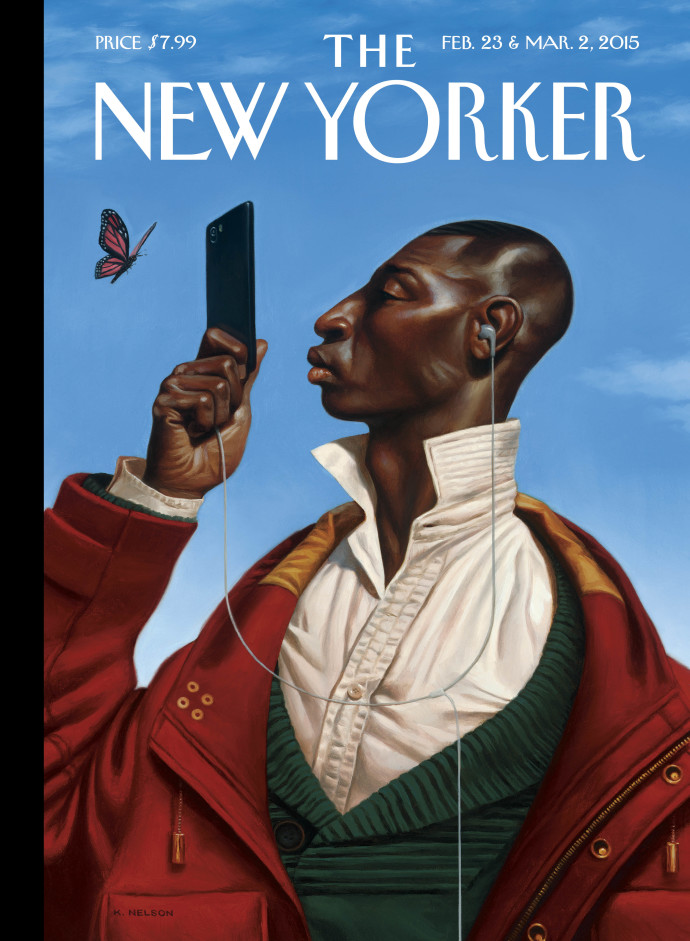KADIR NELSON FOR THE NEW YORKER + A SHORT EXTRACT FROM MY UPCOMING PAPER ON RETROSPECTIVE AFRO-SARTORIALISM
To celebrate its ninetieth anniversary, the next issue of The New Yorker will come out in nine different covers. Each one was handed to an artist with the task of re-imagining the iconic drawing, showing a gentlemen with the beaver hat and monocle (a.k.a.Eustace Tilley), that appeared on the magazine’s first cover of February 1925.
One of the nine covers is an oil painting by Kadir Nelson, showing a modern-day black dandy, impeccably dressed in a red sportsy jacket, green cardigan and starched white shirt, who is intently looking and listening to his cell phone with earplugs. It is only fitting that I encountered this image today, as I touch up an article on retrospective male fashion among the African youths that is forthcoming in Clothing Cultures.

Here’s an extract, complete with references.
Please, do not cite without permission.
Thanks to the relatively recent spread of communication technologies in the continent, African dress practices have now boosted their outreach and imposed themselves as trendsetters on the mainstream and subcultural scene. African designers are rising in the Western market thanks, also, to the promotion of celebrities the likes of Michelle Obama, Lupita Nyong’o and Nicki Minaj (NBC News 2015; Gundan 2015), while street-style blogs based in the metropolitan hubs of the continent inspire a transnational collectivity of young fashionables (Jennings 2012; Chiénin 2015). These two aspects, the successful entrepreneurship of African designers and the fresh style of young urbanites, make Afro-sartorialism a prominent actor of contemporary dress practices, one that begs extended investigation, as its successful circulation contributes to propel the development of a more positive definition of ‘Africanness’ (Comaroff and Comaroff 2009; Wawrzinek and Makokha 2011; Farber 2010). In particular, the currency of the ‘Afropolitan’ (Mbembe 2007), ‘Afro-chic’ (Kauppinen and Spronk 2014), and ‘Afro-cool’ (de Witte 2014) neologisms in scholarly studies and pop-cultural narratives underscores that identity statements of Africanness are conspicuously based in an affirmative spirit of cosmopolitan taste choices and a ‘cool’ lifestyle. Through creative dress and beauty choices, the racial pride and a re-attachment to Africa of urban young adults and media-savvy millennials takes embodied form as an eminently aesthetic and aestheticizing endeavour.
This article offers a set of preliminary and necessarily incomplete notes on the subculture of African dandies, who re-appropriate the styling trends of past generations of Afro-diasporic gentlemen to new aims. While dandyism has a long and respected tradition across many African states, it remains an under-investigated phenomenon, save for analyses of Congolese sapologie (Gandoulou 1989; Bazenguissa, R. and MacGaffey 1995, 2000; Thomas 2003; Gondola 1999). Furthermore, it has found little to no space in the literature on black self-styling (White & White 1999; Tulloch 2010; 2014), in monographic studies on Afro-diasporic dandyism (Miller 2009), and in the journalistic and artistic production on black ‘dappers’ (Caramanica 2010; Lewis 2014; Gebreyes 2015). I engage with this lack of scholarship and with the challenge of looking for the elements and stories that make African dandyism, indeed, African, rather than generally ‘black’, paying attention to the ways in which this aesthetic vocation weaves together a concern with memory and cultural pride, with professional ambitions and self-promotion.
References:
Bazenguissa, R. and MacGaffey, J. (1995), ‘Vivre et briller à Paris. Des jeunes Congolais et Zaïrois en marge de la légalité Économique,’ Politique africaine, 57, pp. 124-133.
______ (2000), Congo-Paris: Transnational Traders on the Margins of the Law, Bloomington: Indiana University Press.
Caramanica, J. (2011), ‘Pushing the Boundaries of Black Style’, http://www.nytimes.com/2011/08/18/fashion/pushing-the-boundaries-of-black-style.html?pagewanted=all&_r=2&. Accessed 11 December 2014.
Chiénin, C. (2015), ‘Meet the Bloggers Who are Influencing African Fashion’, http://www.huffingtonpost.com/chayet-chienin/bloggers-african-fashion_b_6613940.html. Accessed 14 February 2015.
Comaroff, J. and J. (2009), Ethnicity, Inc., Chicago and London: The University of Chicago Press.
de Witte, M. (2014), ‘Heritage, Blackness and Afro-cool’, African Diaspora, 7, pp. 260-289.
Farber, L. (2010), ‘Africanising hybridity? Toward an Afropolitan aesthetic in contemporary South African fashion design’, Critical Arts: South-North Cultural and Media Studies, 24:1, pp. 128-167.
Gandoulou, J. D. (1989), Dandies à Bacongo. Le culte de l’Élégance dans la société congolaise contemporaine, Paris: L’Harmattan.
Gebreyes, R. (2015), ‘Dapper Black Men are Reclaiming their Narratives with Style’, http://www.huffingtonpost.com/2015/02/13/black-men-style_n_6673806.html. Accessed 13 February 2015.
Gondola, D. (1999), ‘Dream and Drama: The Search for Elegance among Congolese Youth’, African Studies Review, 42:1, pp. 23-48.
Gundan, F. (2015), ‘Zimbabwean Designer Behind Nicki Minaj’s Fashion Line; Farai Simoyi’, http://www.forbes.com/sites/faraigundan/2015/02/13/zimbabwean-designer-behind-nicki-minajs-fashion-line-farai-simoyi/. Accessed 13 February 2015.
Jennings, H. (2012), ‘The Top 10 African Fashion Blogs’, http://www.theguardian.com/fashion/fashion-blog/2012/aug/29/top-10-african-fashion-blogs. Accessed 13 February 2015.
Kauppinen, R. and R. Spronk (2014), ‘Afro-chic: Beauty, Ethics, and “Locks without Dread” in Ghana’, in B. Barendregt and R. Jaffe (eds.), Green Consumption: The Global Rise of Eco-Chic, London, New Delhi, New York, Sidney: Bloomsbury
Lewis, S.P. (2014), ‘The Dandy Lion Project’, http://shantrelleplewis.com/?page_id=18 . Accessed 13 December 2014.
Mbembe, A. (2007), ‘Afropolitanism’, in Johannesburg Arts Gallery (ed.), Africa Remix: Contemporary Art of a Continent, Johannesburg: Jacana, pp. 26-30.
Miller, M. (2009), Slaves to Fashion: Black Dandyism and the Styling of Black Diasporic Identity, Durham: Duke University Press.
NBC News, ‘With African Fashion in Vogue, Home Talent Shines’, http://www.nbcnews.com/news/nbcblk/african-fashion-vogue-home-talent-shines-n301876. Accessed 12 February 2015.
Thomas, D. (2003), ‘Fashion Matters: “La Sape” and Vestimentary Codes in Transnational Contexts and Urban Diasporas’, MLN, 118:4, pp. 947-973.
Tulloch, C. (2010), ‘Style-Fashion-Dress: From Black to Post-Black’, Fashion Theory: The Journal of Dress, Body & Culture, 14:3, pp. 273-304.
_________(2014), Black Style, London: V&A Publishing.
Wawrzinek, J. and J.K.S. Makokha (2011), Negotiating Afropolitanism, New York and Amsterdam: Rodopi.
White, S. & White, G. (1999), Stylin’: African American Expressive Culture, from Its Beginnings to the Zoot Suit, New York: Cornell University Press.